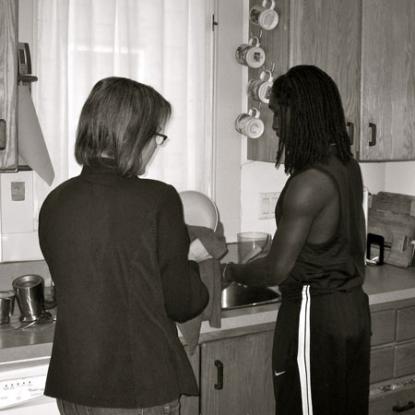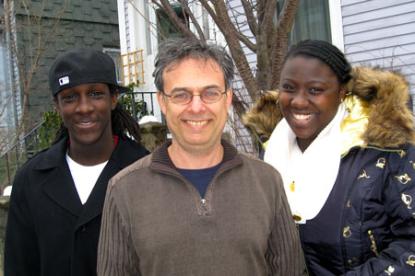
It’s funny how a photograph can stick in your mind. Maybe the stillness of the image gives it time to sink in, like dye, and become part of you.
One image that sticks in my mind is of a White woman, perhaps a little older than I am now, with graying hair, standing in front of a sink. A tall young Black man is standing next to her. They are washing dishes and light enters from a window in front of them. They aren’t facing the camera. They are engaged in the task together. According to the newspaper article accompanying the photo, the young man is the woman’s son. I saw the photo, probably, in 1993 or 1994.
When I first came across the photo I was struck by how ordinary, and yet intimate, the activity of washing dishes together is, and how unusual to see a White woman and a Black man portrayed this way. The two are clearly not a couple, nor is the woman in a “helping” mode with respect to the man. They are family: mother and son.
The article in which the photo appeared was part of a flurry of debate in the early 1990s about transracial adoption. Countering the practice of racial matching in adoption, the Multiethnic Placement Act (MEPA I) was passed in 1994, barring racial discrimination in adoption; changes and clarifications followed in 1996. Racial matching had once been important in adoption – as had matching along every other human dimension – in order for adoptive families to “pass” as biologically related. But intercountry adoptions became more common in the 1960’s and 70’s – partly due to the Korean and Vietnam wars – and they brought a degree of visibility, both literal and figurative, to adoptive families. Over time, domestic race matching, which had been considered the best way to protect adoptive parents from the embarrassment of infertility and adoptees from the shame of illegitimacy, became a way to protect the racial identities of minority children and the cohesion of minority communities. By the early 1990s, however, the number of Black children “in the system” without permanent homes was approaching 200,000.[1] The question arose whether the concept of “protection” should be expanded so that Black children placed in White families could be protected from a life in foster care and group homes. The conclusion drawn, rightly or wrongly, was that transracial adoption is, in many cases, in the best interests of the children and the Black community.
The early 1990’s was also a time when contact between birth families and adoptive families – either direct or mediated by adoption agencies – became the norm in domestic adoptions. There has always been some degree of openness in adoptions in which a child has been taken from their family of origin, and in adoption through foster care, for the child might well have spent years living with their birth family. But through the 1980s and 1990s, partly in response to research on the well-being of adoptees, openness was encouraged in infant adoption.[2] Today, even if ongoing contact is not wanted, birth mothers are given a choice of adoptive families who present themselves in letters and photos as a loving family for the child, and photos or letters to the child are passed to the adoptive family.
These changes[3] – greater numbers of intercountry adoptions, domestic transracial adoptions, and open adoptions, have disrupted the assumption that adoption is something to keep secret. Adoption, according to the new realities, is a perfectly legitimate way to form a family. But our culture has not kept pace with these changing realities. For example, shame remains a theme in the experience of birth mothers and adoptees, and shame’s counterpart attitudes of judgment, criticism, and marginalization, are expressed not only in direct interactions, but also in literature, film, popular culture, and public policies. Loss is also common to all those touched by adoption, yet even if the experience of loss is better than ignorance, we need to ask not only how individuals can be healed, but also how the cultural meaning of family contributes to the sense of shame and loss. How might our culture change so that the circumstances that give rise to adoption are handled ethically and humanely without secrecy, without shame, without marginalization?
In an effort to address some of these questions, the Alliance for the Study of Adoption and Culture will be holding a conference at MIT, April 29-May 2, 2010, on the topic, Adoption: Secret Histories, Public Policies. Simplistic portrayals of adoption fuel stereotypes that stigmatize birthparents and adoptive families; the lack of rich descriptive resources, positive narrative structures, and concrete normative frameworks are challenges for all those involved in adoption. These problems are of the kind that the humanities are designed to address: how have our representations of adoption affected those engaged in it? What new language, new ideas, new narratives are available? As adoption practices change, are we sufficiently alert to both the dangers and possibilities?
In the background of our discussions are questions about how the humanities are situated with respect to other forms of inquiry and life as a whole: How do perspectives on adoption given by film and creative writers relate to more scholarly ones? How does the work of philosophers and historians matter when it comes to raising an adopted child? How can literary critics contribute to and learn from the formation of adoptees’ identities?
forms of inquiry and life as a whole: How do perspectives on adoption given by film and creative writers relate to more scholarly ones? How does the work of philosophers and historians matter when it comes to raising an adopted child? How can literary critics contribute to and learn from the formation of adoptees’ identities?
I’ve spent hours and hours looking through my files, through web archives of newspapers and magazines, and I still can’t find the photo that sticks in my mind. But it is part of me now. My husband and I adopted an African-American baby boy in 1994 and baby girl in 1996; both are open adoptions. My son is 15 now. And sometimes, not often enough, we wash dishes together.
PHOTOS: Courtesy of Sally Haslanger
[2] An important resource for adoption research is the Evan B. Donaldson Adoption Institute.
[3] For more on the history of adoption, see the Adoption History Project.


